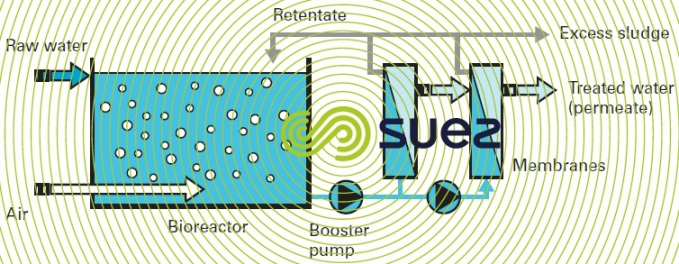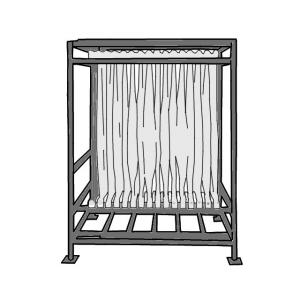Membrane Bioreactor as a Sustainable Solution for High-Volume Wastewater Treatment
Membrane Bioreactor as a Sustainable Solution for High-Volume Wastewater Treatment
Blog Article
Understanding Membrane Bioreactors: The Future of Wastewater Therapy
Membrane layer bioreactors (MBRs) represent a notable innovation in the field of wastewater therapy, incorporating biological procedures with innovative membrane filtering to enhance effluent high quality. As international water scarcity and rigid governing frameworks become progressively pushing issues, MBR technology uses a reliable response with its capability to decrease footprint and enhance source recuperation.
What Are Membrane Layer Bioreactors?

The core parts of MBR systems consist of a bioreactor where microbial task occurs and a membrane unit that filters the blended liquor. This double performance makes it possible for the synchronised destruction of raw material and solid-liquid splitting up in a solitary action. MBRs can run in both immersed and exterior arrangements, with immersed systems being more common due to their compact design and operational performance.
The fostering of MBR modern technology has actually gotten grip in different applications, ranging from local wastewater treatment to industrial effluent management. MBRs are particularly advantageous in scenarios where room is minimal or rigorous effluent high quality requirements should be met. By keeping a high focus of bacteria within the bioreactor, MBRs improve the degradation of natural toxins, consequently producing higher therapy effectiveness compared to traditional approaches.
Trick Benefits of MBR Modern Technology
The combination of biological therapy with membrane filtering in MBR systems offers countless advantages that establish it aside from traditional wastewater therapy methods. Among the primary benefits is the boosted effluent high quality. MBRs effectively eliminate put on hold pathogens and solids, accomplishing greater levels of filtration that meet rigid discharge criteria and help with water reuse applications.

Another considerable benefit is the reduced sludge production. MBR systems produce much less excess sludge, bring about lower disposal expenses and a reduction in ecological influence. The closed nature of the membrane system lessens the threat of smell emissions and enhances general process control.
Finally, MBRs are functional and versatile, making them suitable for different wastewater types, including commercial and local resources. The capacity to incorporate with innovative therapy modern technologies better boosts their effectiveness, making MBRs an appealing solution for the future of wastewater monitoring.
Challenges and Limitations of MBRs
While MBR technology supplies countless advantages, it likewise deals with several difficulties and restrictions that can affect its extensive adoption. One significant challenge is the high capital and operational prices related to MBR systems. The first financial investment for membrane layer materials and the required infrastructure can be substantial, making it much less obtainable for smaller sized industries or municipalities.
In addition, membrane layer fouling stays a critical problem that can diminish system performance and increase maintenance needs. Fouling occurs when solids, natural matter, or microbes collect on the membrane layer surface, leading to minimized permeability and requiring constant cleansing or replacement.
An additional restriction involves the intricacy of the innovation. MBR systems require skilled employees for operation and upkeep, which can be a barrier in areas with restricted technical experience. The disposal of invested membrane layers provides ecological issues, as the products are often not eco-friendly and can contribute to squander monitoring challenges.
Finally, while MBRs can effectively treat a wide variety of wastewater, they might not appropriate for all applications, especially those with high focus of news fats, oils, and oils, necessitating additional study and innovation to attend to these constraints.
Applications of Membrane Bioreactors
In various markets, membrane layer bioreactors (MBRs) have become a flexible remedy for wastewater therapy (Membrane Bioreactor). Their applications span community, commercial, and farming setups, showcasing their adaptability and effectiveness in diverse atmospheres. In metropolitan wastewater therapy plants, MBRs significantly enhance effluent high quality, permitting water reuse and lowering the ecological influence of released wastewater
Industrially, MBRs are employed in food and beverage processing, textile manufacturing, and pharmaceutical production, where they effectively treat high-strength waste streams. Their capability to deal with varying and varying tons pollutant concentrations makes them especially useful in these markets. Furthermore, MBRs assist in the elimination of microorganisms, suspended solids, and raw material, contributing to conformity with rigorous discharge laws.
In farming, MBRs are progressively utilized for treating agricultural drainage and animals wastewater, making it possible for the healing of nutrients for fertilizer production. They additionally help in the treatment of greywater for irrigation, promoting lasting water administration methods.
The flexibility of MBRs is further shown by their combination with other technologies, such as anaerobic food digestion and advanced oxidation processes, boosting general performance and article source healing in wastewater treatment systems.
The Future of Wastewater Therapy
Improvements in innovation and an expanding focus on sustainability are shaping the future of wastewater therapy. Membrane bioreactors (MBRs) exhibit this shift by integrating organic treatment procedures with membrane purification, leading to top quality effluent suitable for reuse. The pattern towards round economic climates is motivating facilities to take on MBRs for their capability to recover resources, such as water and nutrients, from wastewater.
Innovations in membrane layer materials and setup are enhancing the effectiveness and longevity of MBR systems, minimizing operational expenses and power consumption. Smart modern technology integration, consisting of real-time monitoring and automated control systems, is additional maximizing performance and allowing anticipating maintenance, hence minimizing downtime.
Additionally, regulatory pressures and social expectations are pushing communities and industries to adopt more lasting techniques. Membrane Bioreactor. The shift towards decentralized wastewater therapy remedies is gaining traction, enabling local treatment that decreases transport prices and power use
Conclusion
Membrane bioreactors (MBRs) stand for a transformative strategy to wastewater therapy, integrating biological processes with sophisticated membrane layer modern technology. The benefits of MBRs, consisting of enhanced effluent quality, decreased spatial demands, and reduced sludge manufacturing, position them as a feasible option in the middle of expanding urbanization and more stringent environmental regulations. Despite existing challenges, the continued development in membrane materials and operational techniques promises to reinforce the efficacy and adoption of MBRs, ensuring their pivotal role in the future of sustainable wastewater monitoring.
Membrane layer bioreactors (MBRs) stand for a significant advancement in the area of wastewater treatment, integrating biological procedures with sophisticated membrane filtration to enhance effluent quality.Membrane layer bioreactors (MBRs) integrate biological treatment processes with membrane layer filtering to successfully treat wastewater.The integration of organic therapy with membrane filtration in MBR systems supplies countless benefits that set it apart from traditional wastewater therapy techniques. Membrane bioreactors (MBRs) exhibit this change by integrating organic therapy processes with membrane layer filtering, resulting in premium effluent suitable for reuse.Membrane layer bioreactors (MBRs) you can try these out represent a transformative approach to wastewater therapy, integrating organic procedures with advanced membrane layer innovation.
Report this page